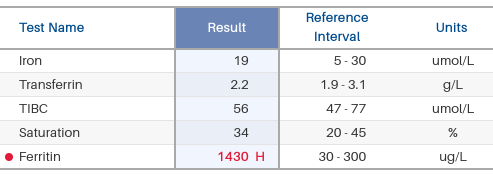Is my iron really high?
Last updated Nov. 2, 2025, 10:52 p.m. by ivo
Tags: Hyperferritinemia , ferritin , iron studies
Here is the report with high ferritin but normal iron, transferrin, transferrin saturation and TIBC. It should be fairly simple to read and interpret. :
- Ferritin - measures your body's total iron stores. Think of it like the amount of iron that’s stored in a warehouse (your liver). A higher ferritin means more iron is stored, but this isn’t always the case, as ferritin can increase for other reasons, like inflammation or liver disease.
- Transferrin - measures how much iron can be carried from storage to the places that needed like bone marrow where red cells are produced. Think of it like delivery trucks that carry iron from the warehouse to iron processing facility. Higher the transferrin value the more trucks are hauling iron
- Saturation - tells you how much iron is actually loaded onto the truck (transferrin) and ready to be delivered.
- Iron - reflects the free iron floating around in your blood, not yet attached to anything. Think of it like iron ore that’s spilled off the truck. Empty trucks cannot spill a lot of iron if any
- Total iron-binding capacity(TIBC) - measures how much iron can be carried in your blood by transferrin. Think of it as the amount of iron which can be loaded onto a truck(transferrin)
Most of the iron in your body is used in red blood cells to carry oxygen, while a smaller amount is used in enzymes and stored in your liver.
Now, about ferritin: It’s usually a good sign of how much iron your body has stored. But it’s not always accurate because ferritin can increase for reasons that aren’t related to iron levels, such as infections, inflammation, liver/kindey diseases, alcohol use and cancers.
In our example the ferritin is high but there is very little spillover as evidenced by normal iron, body is not deploying fewer trucks(transferrin is normal) as is total iron-carrying capacity (normal TIBC) and trucks (transferrin) are not overloaded with iron (normal saturation). Given all these measurements it is clear that high ferritin does NOT reflect high iron storage but more likely it is related to other reasons as mentioned above.
The most common causes of high ferritin in my practice is fatty liver which could be diagnosed with liver ultrasound or Fibroscan. Other causes of high ferritin may be elucidated from patient's medical or social history as well as from further testing such as liver enzymes and renal function.
In summary, while high ferritin may grab your attention as it is high and marked red, it is important to analyse the full report and complementary blood tests before making any conclusion about the significance of high ferritin. In our example patient had fatty liver.
0 comments
There are no comments.
